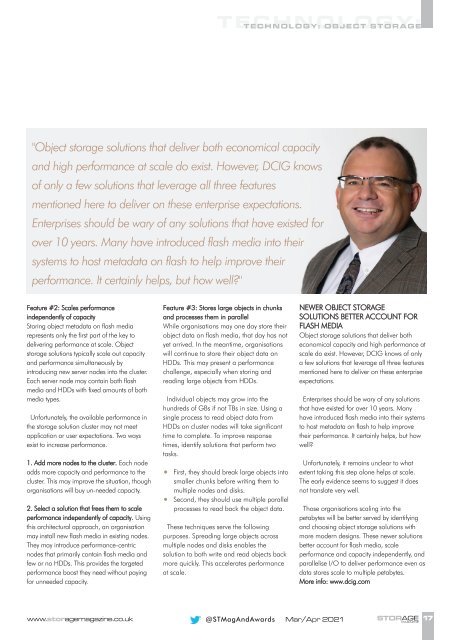You also want an ePaper? Increase the reach of your titles
YUMPU automatically turns print PDFs into web optimized ePapers that Google loves.
TECHNOLOGY: OBJECT <strong>ST</strong>ORAGE<br />
"Object storage solutions that deliver both economical capacity<br />
and high performance at scale do exist. However, DCIG knows<br />
of only a few solutions that leverage all three features<br />
mentioned here to deliver on these enterprise expectations.<br />
Enterprises should be wary of any solutions that have existed for<br />
over 10 years. Many have introduced flash media into their<br />
systems to host metadata on flash to help improve their<br />
performance. It certainly helps, but how well?"<br />
Feature #2: Scales performance<br />
independently of capacity<br />
Storing object metadata on flash media<br />
represents only the first part of the key to<br />
delivering performance at scale. Object<br />
storage solutions typically scale out capacity<br />
and performance simultaneously by<br />
introducing new server nodes into the cluster.<br />
Each server node may contain both flash<br />
media and HDDs with fixed amounts of both<br />
media types.<br />
Unfortunately, the available performance in<br />
the storage solution cluster may not meet<br />
application or user expectations. Two ways<br />
exist to increase performance.<br />
1. Add more nodes to the cluster. Each node<br />
adds more capacity and performance to the<br />
cluster. This may improve the situation, though<br />
organisations will buy un-needed capacity.<br />
2. Select a solution that frees them to scale<br />
performance independently of capacity. Using<br />
this architectural approach, an organisation<br />
may install new flash media in existing nodes.<br />
They may introduce performance-centric<br />
nodes that primarily contain flash media and<br />
few or no HDDs. This provides the targeted<br />
performance boost they need without paying<br />
for unneeded capacity.<br />
Feature #3: Stores large objects in chunks<br />
and processes them in parallel<br />
While organisations may one day store their<br />
object data on flash media, that day has not<br />
yet arrived. In the meantime, organisations<br />
will continue to store their object data on<br />
HDDs. This may present a performance<br />
challenge, especially when storing and<br />
reading large objects from HDDs.<br />
Individual objects may grow into the<br />
hundreds of GBs if not TBs in size. Using a<br />
single process to read object data from<br />
HDDs on cluster nodes will take significant<br />
time to complete. To improve response<br />
times, identify solutions that perform two<br />
tasks.<br />
First, they should break large objects into<br />
smaller chunks before writing them to<br />
multiple nodes and disks.<br />
Second, they should use multiple parallel<br />
processes to read back the object data.<br />
These techniques serve the following<br />
purposes. Spreading large objects across<br />
multiple nodes and disks enables the<br />
solution to both write and read objects back<br />
more quickly. This accelerates performance<br />
at scale.<br />
NEWER OBJECT <strong>ST</strong>ORAGE<br />
SOLUTIONS BETTER ACCOUNT FOR<br />
FLASH MEDIA<br />
Object storage solutions that deliver both<br />
economical capacity and high performance at<br />
scale do exist. However, DCIG knows of only<br />
a few solutions that leverage all three features<br />
mentioned here to deliver on these enterprise<br />
expectations.<br />
Enterprises should be wary of any solutions<br />
that have existed for over 10 years. Many<br />
have introduced flash media into their systems<br />
to host metadata on flash to help improve<br />
their performance. It certainly helps, but how<br />
well?<br />
Unfortunately, it remains unclear to what<br />
extent taking this step alone helps at scale.<br />
The early evidence seems to suggest it does<br />
not translate very well.<br />
Those organisations scaling into the<br />
petabytes will be better served by identifying<br />
and choosing object storage solutions with<br />
more modern designs. These newer solutions<br />
better account for flash media, scale<br />
performance and capacity independently, and<br />
parallelise I/O to deliver performance even as<br />
data stores scale to multiple petabytes.<br />
More info: www.dcig.com<br />
www.storagemagazine.co.uk<br />
@<strong>ST</strong>MagAndAwards <strong>Mar</strong>/<strong>Apr</strong> <strong>2021</strong><br />
<strong>ST</strong>ORAGE<br />
MAGAZINE<br />
17

















